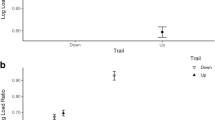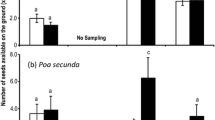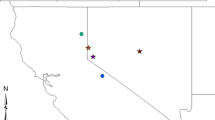Summary
Understanding the foraging behavior of an animal is critically dependent upon knowledge of the constraints on that animal. In this study, I tested whether fidelity to foraging direction acts as a behavioral constraint to foraging western harvester ants, Pogonomyrmex occidentalis. Individual P. occidentalis foragers showed strong fidelity to foraging route and direction. Directional fidelity in this population was not related to trunk trail use, food specialization, colony activity levels, or mortality risks. Directional fidelity constrained individual foraging decisions; when colonies were offered seeds of different quality in 2 directions, individuals did not switch directions to obtain the energetically more rewarding seeds. Colony-level recruitment was increased for energetically more profitable seeds, indicating that colonial responses may compensate for the constraints of directional fidelity on individual foragers.
Similar content being viewed by others
References
Bernstein RA (1975) Foraging strategies of ants in response to variable food density. Ecology 56:312–319
Box TW (1960) Notes on the harvester ant Pogonomyrmex barbatus, var. molefacieus, in South Texas. Ecology 41:381–382
Cheverton J, Kacelnik A, Krebs JR (1985) Optimal foraging: Constraints and currencies. In: Hölldobler B, Lindauer M (eds) Experimental Behavioral Ecology and Sociobiology, Fischer, Stuttgart, pp 109–126
Davidson DW (1977a) Species diversity and community organization in desert seed-eating ants. Ecology 58:711–724
Davidson DW (1977b) Foraging ecology and community organization in desert seed-eating ants. Ecology 58:725–727
Davidson DW (1978) Experimental tests of the optimal diet in two social insects. Behav Ecol Sociobiol 4:35–41
DeVita J (1979) Mechanisms of interference and foraging among colonies of the harvester ant Pogonomyrmex californicus in the Mojave desert. Ecology 60:729–731
Fewell JH (1988a) Energetic and time costs of foraging in western harvester ants, Pogonomyrmex occidentalis. Behav Ecol Sociobiol 22:401–408
Fewell JH (1988b) Variation in the foraging patterns of the ant, Pogonomyrmex occidentalis in relation to variation in habitat structure. In: Jeanne RL (ed) Inter-Individual Variation in Social Insect Behavior. Westview Press, Boulder, Colorado, pp 257–282
Franks NR (1986) Teams in social insects: Group retrieval of prey by army ants (Eciton burchelli, Hymenoptera: Formicidae). Behav Ecol Sociobiol 18:425–429
Fresneau D (1985) Individual foraging and path fidelity in a Ponerine ant. Insectes Sociaux 32:109–116
Hahn M, Maschwitz U (1985) Foraging strategies and recruitment behaviour in the European harvester ant Messor rufitarsis (F.). Oecologia 68:45–51
Harkness RD, Maroudas NG (1985) Central place foraging by an ant (Cataglyphis bicolor Fab.): a model of searching. Anim Behav 33:916–928
Harrison JM, Fewell JH, Stiller TM, Breed MD (1989) The effect of experience on cues used during orientation to food in the giant tropical ant, Paraponera clavata. Anim Behav 37:869–871
Herbers JM (1981) Reliability theory and foraging by ants. J Theor Biol 89:175–189
Hölldobler B (1974) Home range orientation and territoriality in harvesting ants, Pogonomyrmex. Proc Natl Acad Sci USA 71:3271–3277
Hölldobler B (1976) Recruitment behavior, home range orientation and territoriality in harvester ants, Pogonomyrmex. Behav Ecol Sociobiol 1:3–44
Hölldobler B, Wilson EO (1970) Recruitment trails in the harvester ant Pogonomyrmex badius. Psyche 77:385–399
Kelrick MI, MacMahon JA, Parmenter RR, Sisson DV (1986) Native seed preferences of shrub-steppe rodents, birds and ants: the relationships of seed attributes and seed use. Oecologia 68:327–337
Lewis D, Burke LJ (1949) The use and misuse of the chi-square test. Psych Bull 46:433–489
Oster GF, Wilson EO (1978) Caste and Ecology in the Social Insects, Monogr Pop Biol 12. Princeton University Press, Princeton
Paine RT (1971) The measurement and application of the calorie to ecological problems. Ann Rev Ecol Syst 2:145–164
Pasteels JM, Deneubourg JL, Goss S (1987) Self-organization mechanisms in ant societies (I): Trail recruitment to newly discovered food sources. Exp [Suppl 54], Behavior in Social Insects. Birkhäuser, Basel
Porter SD, Jorgensen CD (1981) Foragers of the harvester ant, Pogonomyrmex owyheei: a disposable caste? Behav Ecol Sociobiol 9:247–256
Rissing SW (1981) Prey preferences in the desert horned lizard: influence of prey foraging method and aggressive behavior. Ecology 62:1031–1040
Rissing SW, Pollack GB (1984) Worker size variability and foraging efficiency in Veromessor pergandei (Hymenoptera: Formicidae). Behav Ecol Sociobiol 15:121–126
Rogers LE (1972) The ecological effects of the western harvester ant (Pogonomyrmex occidentalis) in the shortgrass plains ecosystem. USIBP Tech Rep 206:1–109
Rosengren R (1971) Route fidelity, visual memory and recruitment behavior in foraging wood ants of the genus Formica. Acta Zool Fenn 133:3–106
Stephens D, Krebs J (1986) Foraging Theory. Princeton University Press, Princeton, NJ
Taylor F (1977) Foraging behavior of ants: Experiments with two species of Myrmecine ants. Behav Ecol Sociobiol 2:147–167
Traniello JFA, Fujita MS, Bowen RV (1984) Ant foraging behavior: ambient temperature influences prey selection. Behav Ecol Sociobiol 15:65–68
Wehner R, Harkness RD, Schmid-Hempel P (1983) Foraging strategies in individually searching ants Cataglyphis bicolor (Hymenoptera: Formicidae). In: Lindauer M (ed) Information Processing in Animals 1. Fischer, NY
Whitford WG (1978) Foraging in seed-harvester ants Pogonomyrmex spp. Ecology 60:686–694
Wilson EO (1978) Division of labor based on physical castes in fire ants (Hymenoptera: Formicidae: Solenopsis). J Kans Entomol Soc 51:615–636
Author information
Authors and Affiliations
Rights and permissions
About this article
Cite this article
Fewell, J.H. Directional fidelity as a foraging constraint in the western harvester ant, Pogonomyrmex occidentalis . Oecologia 82, 45–51 (1990). https://doi.org/10.1007/BF00318532
Received:
Accepted:
Issue Date:
DOI: https://doi.org/10.1007/BF00318532




